Detailed Analysis of Contract Law: Elements, Types, and Liability
VerifiedAdded on 2019/12/03
|12
|4294
|33
Report
AI Summary
This report provides a comprehensive analysis of contract law, beginning with the essential elements required for a valid contract, such as offer and acceptance, consideration, and capacity. It then delves into the impact of different types of contracts, including unilateral, bilateral, written, oral, face-to-face, and distance contracts, on business operations. The report further examines the analysis of contract terms, differentiating between express and implied terms, and their implications. The second part of the report contrasts contractual liability with liability in tort, focusing on negligence and employer's liability, including the duty of care and breach of duty. It concludes with a discussion of vicarious liability, providing examples of how it applies in business situations and the responsibilities of employers. The report uses case studies and examples to illustrate key concepts and legal principles.
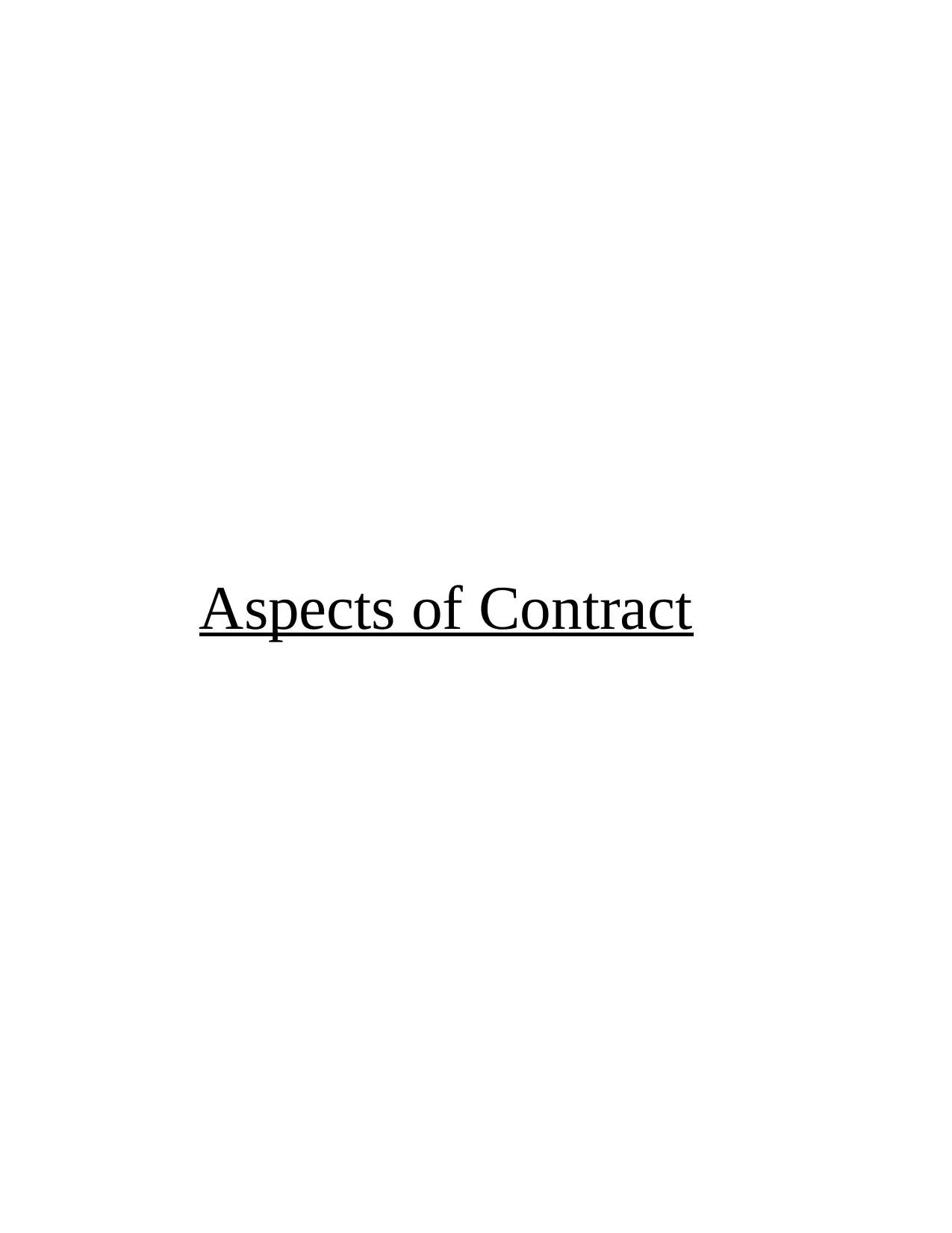
Aspects of Contract
Paraphrase This Document
Need a fresh take? Get an instant paraphrase of this document with our AI Paraphraser
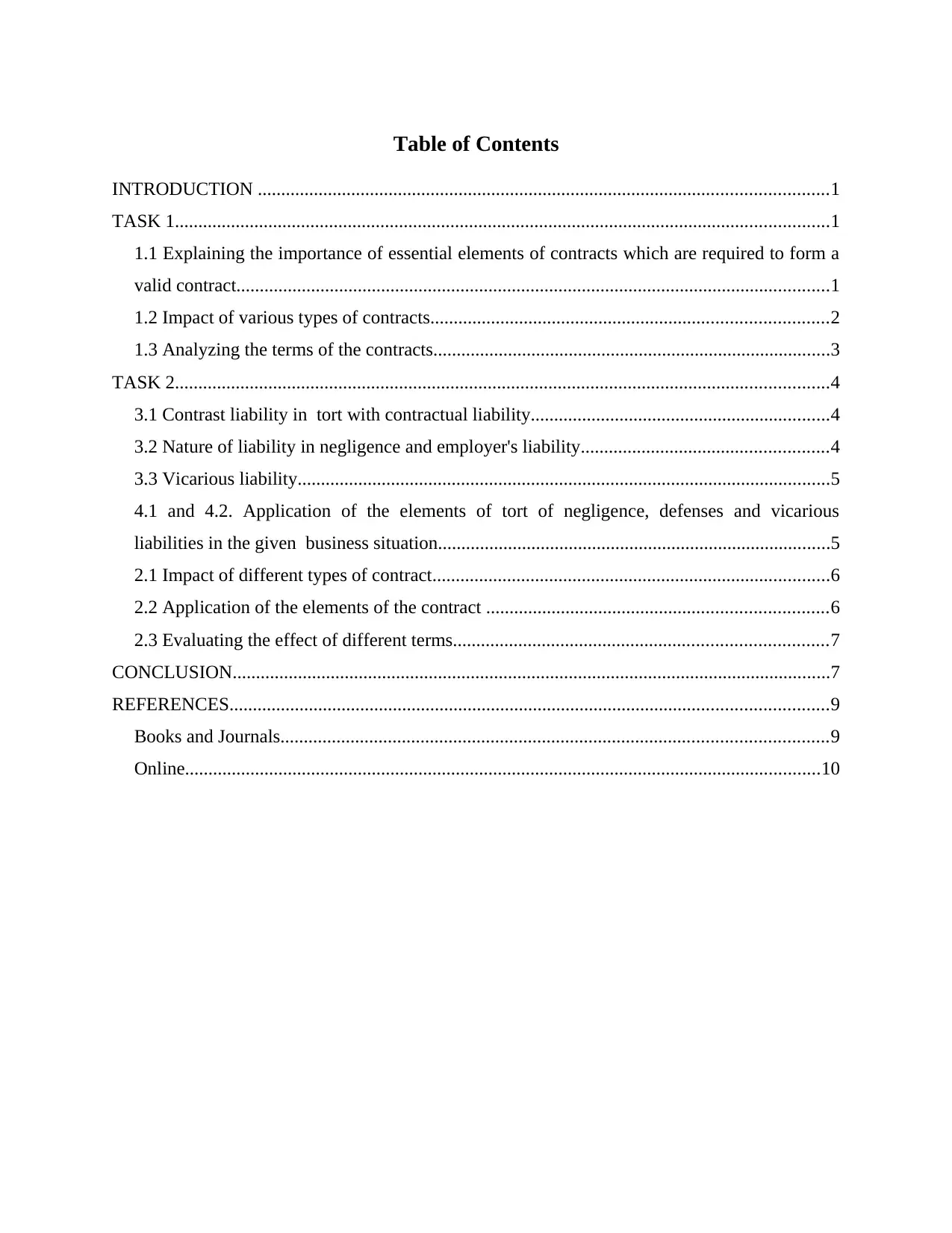
Table of Contents
INTRODUCTION ..........................................................................................................................1
TASK 1............................................................................................................................................1
1.1 Explaining the importance of essential elements of contracts which are required to form a
valid contract...............................................................................................................................1
1.2 Impact of various types of contracts.....................................................................................2
1.3 Analyzing the terms of the contracts.....................................................................................3
TASK 2............................................................................................................................................4
3.1 Contrast liability in tort with contractual liability................................................................4
3.2 Nature of liability in negligence and employer's liability.....................................................4
3.3 Vicarious liability..................................................................................................................5
4.1 and 4.2. Application of the elements of tort of negligence, defenses and vicarious
liabilities in the given business situation....................................................................................5
2.1 Impact of different types of contract.....................................................................................6
2.2 Application of the elements of the contract .........................................................................6
2.3 Evaluating the effect of different terms................................................................................7
CONCLUSION................................................................................................................................7
REFERENCES................................................................................................................................9
Books and Journals.....................................................................................................................9
Online........................................................................................................................................10
INTRODUCTION ..........................................................................................................................1
TASK 1............................................................................................................................................1
1.1 Explaining the importance of essential elements of contracts which are required to form a
valid contract...............................................................................................................................1
1.2 Impact of various types of contracts.....................................................................................2
1.3 Analyzing the terms of the contracts.....................................................................................3
TASK 2............................................................................................................................................4
3.1 Contrast liability in tort with contractual liability................................................................4
3.2 Nature of liability in negligence and employer's liability.....................................................4
3.3 Vicarious liability..................................................................................................................5
4.1 and 4.2. Application of the elements of tort of negligence, defenses and vicarious
liabilities in the given business situation....................................................................................5
2.1 Impact of different types of contract.....................................................................................6
2.2 Application of the elements of the contract .........................................................................6
2.3 Evaluating the effect of different terms................................................................................7
CONCLUSION................................................................................................................................7
REFERENCES................................................................................................................................9
Books and Journals.....................................................................................................................9
Online........................................................................................................................................10
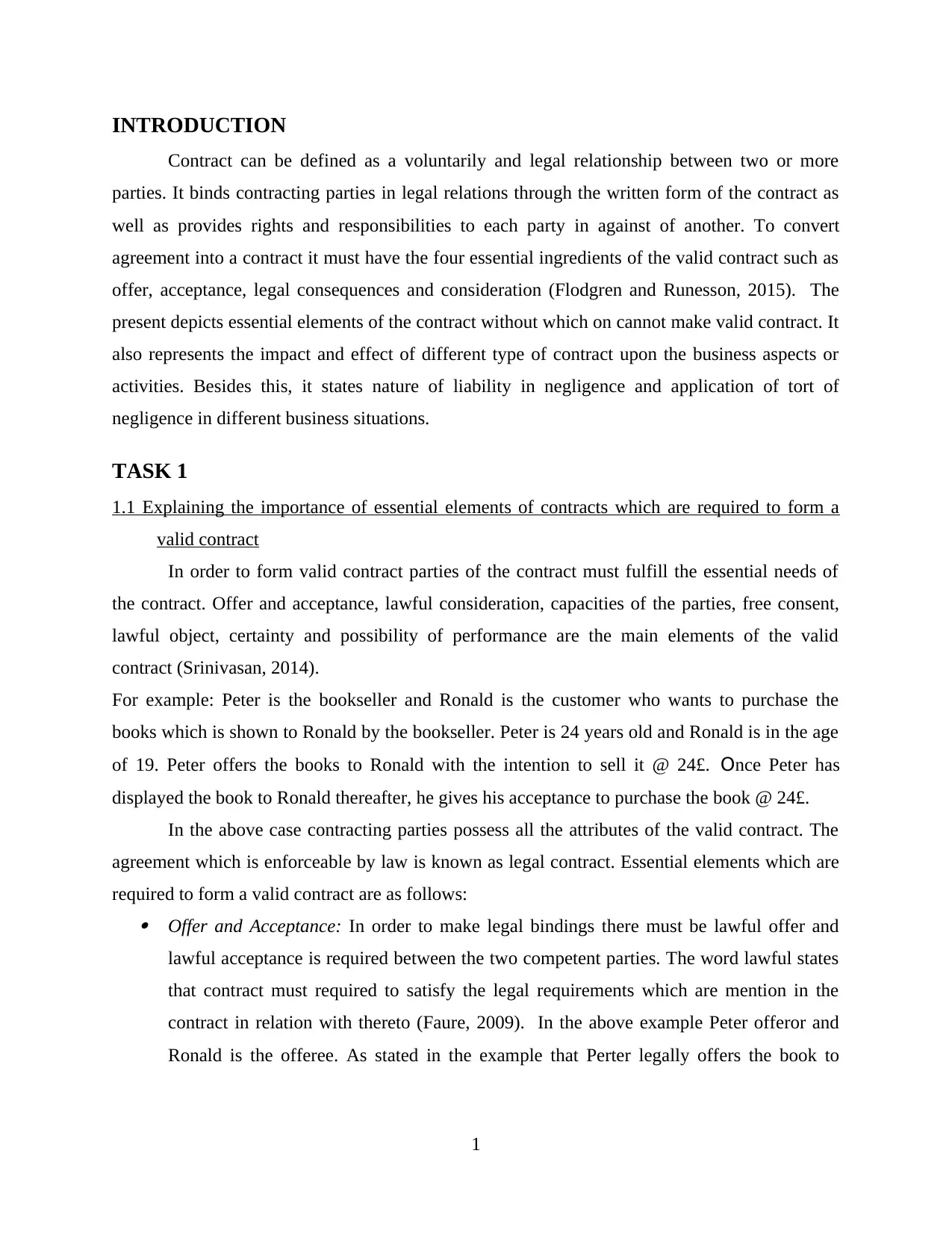
INTRODUCTION
Contract can be defined as a voluntarily and legal relationship between two or more
parties. It binds contracting parties in legal relations through the written form of the contract as
well as provides rights and responsibilities to each party in against of another. To convert
agreement into a contract it must have the four essential ingredients of the valid contract such as
offer, acceptance, legal consequences and consideration (Flodgren and Runesson, 2015). The
present depicts essential elements of the contract without which on cannot make valid contract. It
also represents the impact and effect of different type of contract upon the business aspects or
activities. Besides this, it states nature of liability in negligence and application of tort of
negligence in different business situations.
TASK 1
1.1 Explaining the importance of essential elements of contracts which are required to form a
valid contract
In order to form valid contract parties of the contract must fulfill the essential needs of
the contract. Offer and acceptance, lawful consideration, capacities of the parties, free consent,
lawful object, certainty and possibility of performance are the main elements of the valid
contract (Srinivasan, 2014).
For example: Peter is the bookseller and Ronald is the customer who wants to purchase the
books which is shown to Ronald by the bookseller. Peter is 24 years old and Ronald is in the age
of 19. Peter offers the books to Ronald with the intention to sell it @ 24£. Once Peter has
displayed the book to Ronald thereafter, he gives his acceptance to purchase the book @ 24£.
In the above case contracting parties possess all the attributes of the valid contract. The
agreement which is enforceable by law is known as legal contract. Essential elements which are
required to form a valid contract are as follows: Offer and Acceptance: In order to make legal bindings there must be lawful offer and
lawful acceptance is required between the two competent parties. The word lawful states
that contract must required to satisfy the legal requirements which are mention in the
contract in relation with thereto (Faure, 2009). In the above example Peter offeror and
Ronald is the offeree. As stated in the example that Perter legally offers the book to
1
Contract can be defined as a voluntarily and legal relationship between two or more
parties. It binds contracting parties in legal relations through the written form of the contract as
well as provides rights and responsibilities to each party in against of another. To convert
agreement into a contract it must have the four essential ingredients of the valid contract such as
offer, acceptance, legal consequences and consideration (Flodgren and Runesson, 2015). The
present depicts essential elements of the contract without which on cannot make valid contract. It
also represents the impact and effect of different type of contract upon the business aspects or
activities. Besides this, it states nature of liability in negligence and application of tort of
negligence in different business situations.
TASK 1
1.1 Explaining the importance of essential elements of contracts which are required to form a
valid contract
In order to form valid contract parties of the contract must fulfill the essential needs of
the contract. Offer and acceptance, lawful consideration, capacities of the parties, free consent,
lawful object, certainty and possibility of performance are the main elements of the valid
contract (Srinivasan, 2014).
For example: Peter is the bookseller and Ronald is the customer who wants to purchase the
books which is shown to Ronald by the bookseller. Peter is 24 years old and Ronald is in the age
of 19. Peter offers the books to Ronald with the intention to sell it @ 24£. Once Peter has
displayed the book to Ronald thereafter, he gives his acceptance to purchase the book @ 24£.
In the above case contracting parties possess all the attributes of the valid contract. The
agreement which is enforceable by law is known as legal contract. Essential elements which are
required to form a valid contract are as follows: Offer and Acceptance: In order to make legal bindings there must be lawful offer and
lawful acceptance is required between the two competent parties. The word lawful states
that contract must required to satisfy the legal requirements which are mention in the
contract in relation with thereto (Faure, 2009). In the above example Peter offeror and
Ronald is the offeree. As stated in the example that Perter legally offers the book to
1
⊘ This is a preview!⊘
Do you want full access?
Subscribe today to unlock all pages.

Trusted by 1+ million students worldwide
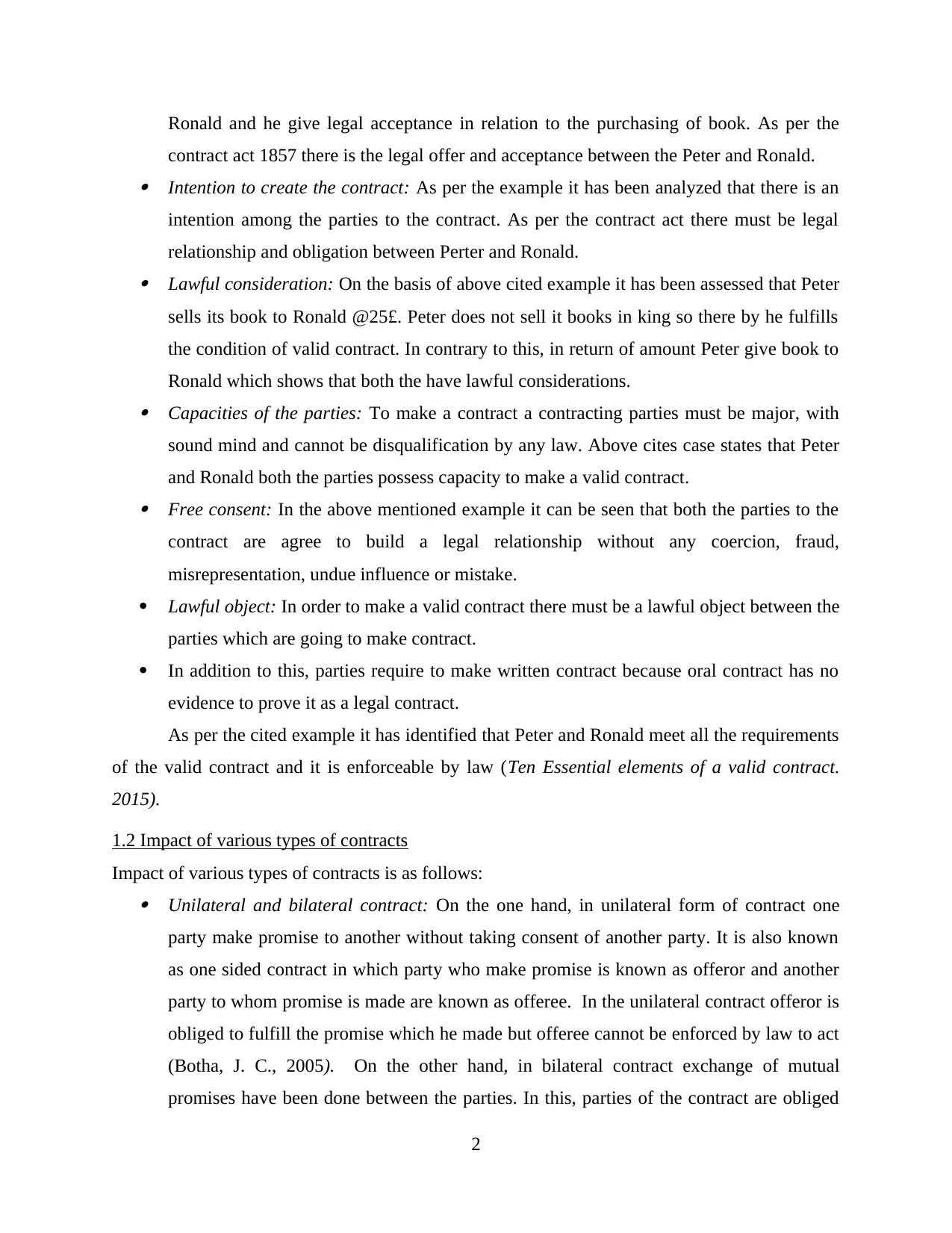
Ronald and he give legal acceptance in relation to the purchasing of book. As per the
contract act 1857 there is the legal offer and acceptance between the Peter and Ronald. Intention to create the contract: As per the example it has been analyzed that there is an
intention among the parties to the contract. As per the contract act there must be legal
relationship and obligation between Perter and Ronald. Lawful consideration: On the basis of above cited example it has been assessed that Peter
sells its book to Ronald @25£. Peter does not sell it books in king so there by he fulfills
the condition of valid contract. In contrary to this, in return of amount Peter give book to
Ronald which shows that both the have lawful considerations. Capacities of the parties: To make a contract a contracting parties must be major, with
sound mind and cannot be disqualification by any law. Above cites case states that Peter
and Ronald both the parties possess capacity to make a valid contract. Free consent: In the above mentioned example it can be seen that both the parties to the
contract are agree to build a legal relationship without any coercion, fraud,
misrepresentation, undue influence or mistake.
Lawful object: In order to make a valid contract there must be a lawful object between the
parties which are going to make contract.
In addition to this, parties require to make written contract because oral contract has no
evidence to prove it as a legal contract.
As per the cited example it has identified that Peter and Ronald meet all the requirements
of the valid contract and it is enforceable by law (Ten Essential elements of a valid contract.
2015).
1.2 Impact of various types of contracts
Impact of various types of contracts is as follows: Unilateral and bilateral contract: On the one hand, in unilateral form of contract one
party make promise to another without taking consent of another party. It is also known
as one sided contract in which party who make promise is known as offeror and another
party to whom promise is made are known as offeree. In the unilateral contract offeror is
obliged to fulfill the promise which he made but offeree cannot be enforced by law to act
(Botha, J. C., 2005). On the other hand, in bilateral contract exchange of mutual
promises have been done between the parties. In this, parties of the contract are obliged
2
contract act 1857 there is the legal offer and acceptance between the Peter and Ronald. Intention to create the contract: As per the example it has been analyzed that there is an
intention among the parties to the contract. As per the contract act there must be legal
relationship and obligation between Perter and Ronald. Lawful consideration: On the basis of above cited example it has been assessed that Peter
sells its book to Ronald @25£. Peter does not sell it books in king so there by he fulfills
the condition of valid contract. In contrary to this, in return of amount Peter give book to
Ronald which shows that both the have lawful considerations. Capacities of the parties: To make a contract a contracting parties must be major, with
sound mind and cannot be disqualification by any law. Above cites case states that Peter
and Ronald both the parties possess capacity to make a valid contract. Free consent: In the above mentioned example it can be seen that both the parties to the
contract are agree to build a legal relationship without any coercion, fraud,
misrepresentation, undue influence or mistake.
Lawful object: In order to make a valid contract there must be a lawful object between the
parties which are going to make contract.
In addition to this, parties require to make written contract because oral contract has no
evidence to prove it as a legal contract.
As per the cited example it has identified that Peter and Ronald meet all the requirements
of the valid contract and it is enforceable by law (Ten Essential elements of a valid contract.
2015).
1.2 Impact of various types of contracts
Impact of various types of contracts is as follows: Unilateral and bilateral contract: On the one hand, in unilateral form of contract one
party make promise to another without taking consent of another party. It is also known
as one sided contract in which party who make promise is known as offeror and another
party to whom promise is made are known as offeree. In the unilateral contract offeror is
obliged to fulfill the promise which he made but offeree cannot be enforced by law to act
(Botha, J. C., 2005). On the other hand, in bilateral contract exchange of mutual
promises have been done between the parties. In this, parties of the contract are obliged
2
Paraphrase This Document
Need a fresh take? Get an instant paraphrase of this document with our AI Paraphraser
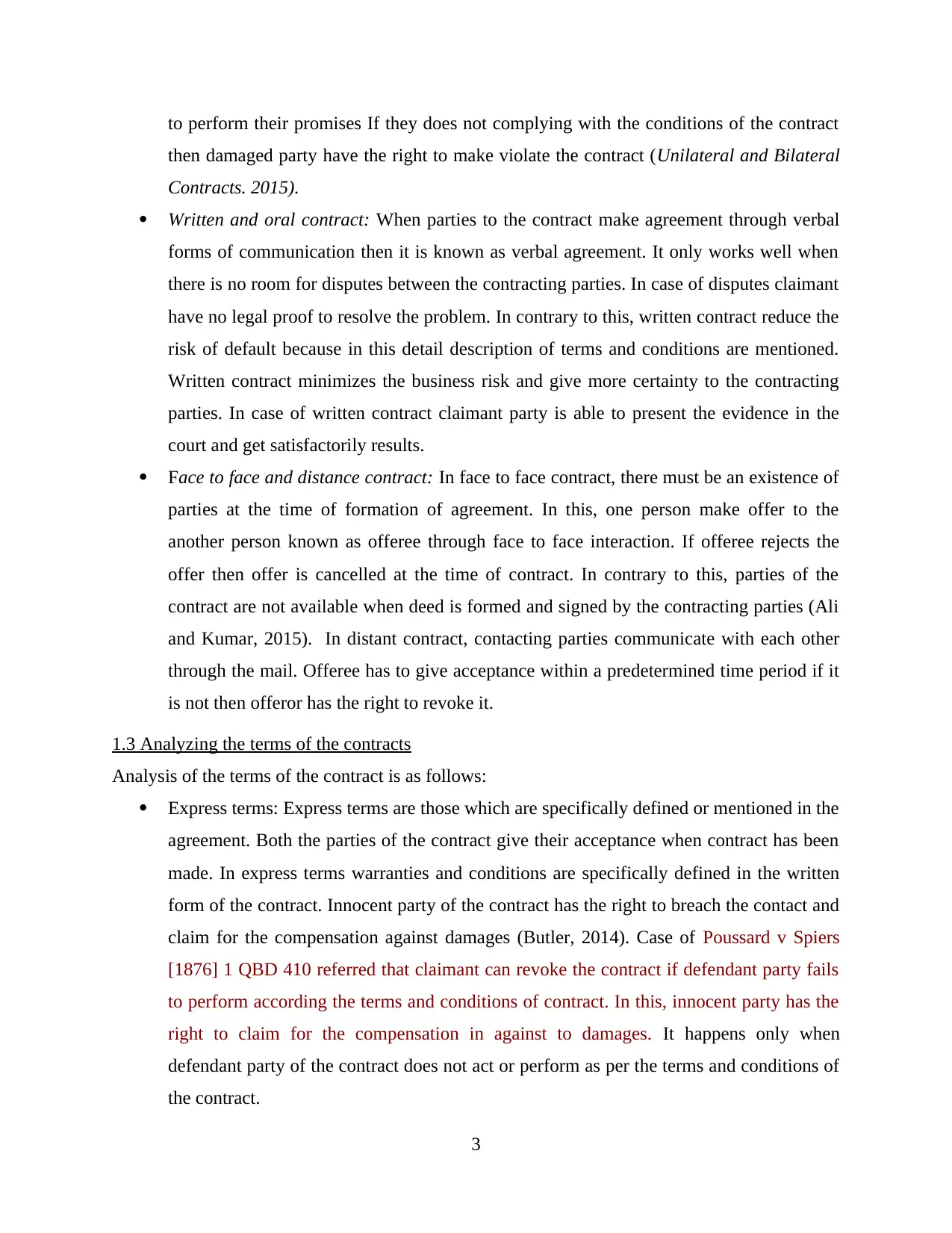
to perform their promises If they does not complying with the conditions of the contract
then damaged party have the right to make violate the contract (Unilateral and Bilateral
Contracts. 2015).
Written and oral contract: When parties to the contract make agreement through verbal
forms of communication then it is known as verbal agreement. It only works well when
there is no room for disputes between the contracting parties. In case of disputes claimant
have no legal proof to resolve the problem. In contrary to this, written contract reduce the
risk of default because in this detail description of terms and conditions are mentioned.
Written contract minimizes the business risk and give more certainty to the contracting
parties. In case of written contract claimant party is able to present the evidence in the
court and get satisfactorily results.
Face to face and distance contract: In face to face contract, there must be an existence of
parties at the time of formation of agreement. In this, one person make offer to the
another person known as offeree through face to face interaction. If offeree rejects the
offer then offer is cancelled at the time of contract. In contrary to this, parties of the
contract are not available when deed is formed and signed by the contracting parties (Ali
and Kumar, 2015). In distant contract, contacting parties communicate with each other
through the mail. Offeree has to give acceptance within a predetermined time period if it
is not then offeror has the right to revoke it.
1.3 Analyzing the terms of the contracts
Analysis of the terms of the contract is as follows:
Express terms: Express terms are those which are specifically defined or mentioned in the
agreement. Both the parties of the contract give their acceptance when contract has been
made. In express terms warranties and conditions are specifically defined in the written
form of the contract. Innocent party of the contract has the right to breach the contact and
claim for the compensation against damages (Butler, 2014). Case of Poussard v Spiers
[1876] 1 QBD 410 referred that claimant can revoke the contract if defendant party fails
to perform according the terms and conditions of contract. In this, innocent party has the
right to claim for the compensation in against to damages. It happens only when
defendant party of the contract does not act or perform as per the terms and conditions of
the contract.
3
then damaged party have the right to make violate the contract (Unilateral and Bilateral
Contracts. 2015).
Written and oral contract: When parties to the contract make agreement through verbal
forms of communication then it is known as verbal agreement. It only works well when
there is no room for disputes between the contracting parties. In case of disputes claimant
have no legal proof to resolve the problem. In contrary to this, written contract reduce the
risk of default because in this detail description of terms and conditions are mentioned.
Written contract minimizes the business risk and give more certainty to the contracting
parties. In case of written contract claimant party is able to present the evidence in the
court and get satisfactorily results.
Face to face and distance contract: In face to face contract, there must be an existence of
parties at the time of formation of agreement. In this, one person make offer to the
another person known as offeree through face to face interaction. If offeree rejects the
offer then offer is cancelled at the time of contract. In contrary to this, parties of the
contract are not available when deed is formed and signed by the contracting parties (Ali
and Kumar, 2015). In distant contract, contacting parties communicate with each other
through the mail. Offeree has to give acceptance within a predetermined time period if it
is not then offeror has the right to revoke it.
1.3 Analyzing the terms of the contracts
Analysis of the terms of the contract is as follows:
Express terms: Express terms are those which are specifically defined or mentioned in the
agreement. Both the parties of the contract give their acceptance when contract has been
made. In express terms warranties and conditions are specifically defined in the written
form of the contract. Innocent party of the contract has the right to breach the contact and
claim for the compensation against damages (Butler, 2014). Case of Poussard v Spiers
[1876] 1 QBD 410 referred that claimant can revoke the contract if defendant party fails
to perform according the terms and conditions of contract. In this, innocent party has the
right to claim for the compensation in against to damages. It happens only when
defendant party of the contract does not act or perform as per the terms and conditions of
the contract.
3
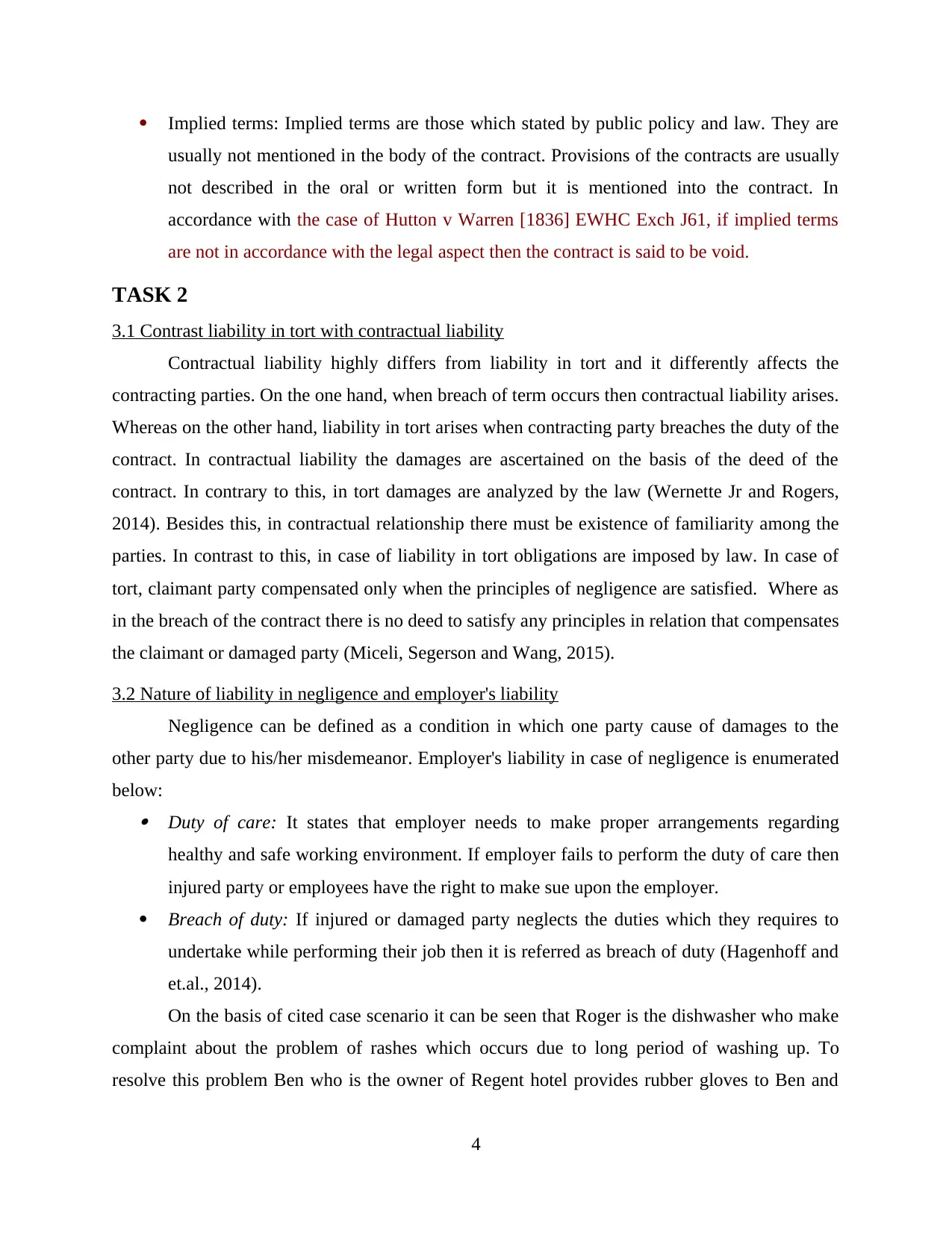
Implied terms: Implied terms are those which stated by public policy and law. They are
usually not mentioned in the body of the contract. Provisions of the contracts are usually
not described in the oral or written form but it is mentioned into the contract. In
accordance with the case of Hutton v Warren [1836] EWHC Exch J61, if implied terms
are not in accordance with the legal aspect then the contract is said to be void.
TASK 2
3.1 Contrast liability in tort with contractual liability
Contractual liability highly differs from liability in tort and it differently affects the
contracting parties. On the one hand, when breach of term occurs then contractual liability arises.
Whereas on the other hand, liability in tort arises when contracting party breaches the duty of the
contract. In contractual liability the damages are ascertained on the basis of the deed of the
contract. In contrary to this, in tort damages are analyzed by the law (Wernette Jr and Rogers,
2014). Besides this, in contractual relationship there must be existence of familiarity among the
parties. In contrast to this, in case of liability in tort obligations are imposed by law. In case of
tort, claimant party compensated only when the principles of negligence are satisfied. Where as
in the breach of the contract there is no deed to satisfy any principles in relation that compensates
the claimant or damaged party (Miceli, Segerson and Wang, 2015).
3.2 Nature of liability in negligence and employer's liability
Negligence can be defined as a condition in which one party cause of damages to the
other party due to his/her misdemeanor. Employer's liability in case of negligence is enumerated
below: Duty of care: It states that employer needs to make proper arrangements regarding
healthy and safe working environment. If employer fails to perform the duty of care then
injured party or employees have the right to make sue upon the employer.
Breach of duty: If injured or damaged party neglects the duties which they requires to
undertake while performing their job then it is referred as breach of duty (Hagenhoff and
et.al., 2014).
On the basis of cited case scenario it can be seen that Roger is the dishwasher who make
complaint about the problem of rashes which occurs due to long period of washing up. To
resolve this problem Ben who is the owner of Regent hotel provides rubber gloves to Ben and
4
usually not mentioned in the body of the contract. Provisions of the contracts are usually
not described in the oral or written form but it is mentioned into the contract. In
accordance with the case of Hutton v Warren [1836] EWHC Exch J61, if implied terms
are not in accordance with the legal aspect then the contract is said to be void.
TASK 2
3.1 Contrast liability in tort with contractual liability
Contractual liability highly differs from liability in tort and it differently affects the
contracting parties. On the one hand, when breach of term occurs then contractual liability arises.
Whereas on the other hand, liability in tort arises when contracting party breaches the duty of the
contract. In contractual liability the damages are ascertained on the basis of the deed of the
contract. In contrary to this, in tort damages are analyzed by the law (Wernette Jr and Rogers,
2014). Besides this, in contractual relationship there must be existence of familiarity among the
parties. In contrast to this, in case of liability in tort obligations are imposed by law. In case of
tort, claimant party compensated only when the principles of negligence are satisfied. Where as
in the breach of the contract there is no deed to satisfy any principles in relation that compensates
the claimant or damaged party (Miceli, Segerson and Wang, 2015).
3.2 Nature of liability in negligence and employer's liability
Negligence can be defined as a condition in which one party cause of damages to the
other party due to his/her misdemeanor. Employer's liability in case of negligence is enumerated
below: Duty of care: It states that employer needs to make proper arrangements regarding
healthy and safe working environment. If employer fails to perform the duty of care then
injured party or employees have the right to make sue upon the employer.
Breach of duty: If injured or damaged party neglects the duties which they requires to
undertake while performing their job then it is referred as breach of duty (Hagenhoff and
et.al., 2014).
On the basis of cited case scenario it can be seen that Roger is the dishwasher who make
complaint about the problem of rashes which occurs due to long period of washing up. To
resolve this problem Ben who is the owner of Regent hotel provides rubber gloves to Ben and
4
⊘ This is a preview!⊘
Do you want full access?
Subscribe today to unlock all pages.

Trusted by 1+ million students worldwide
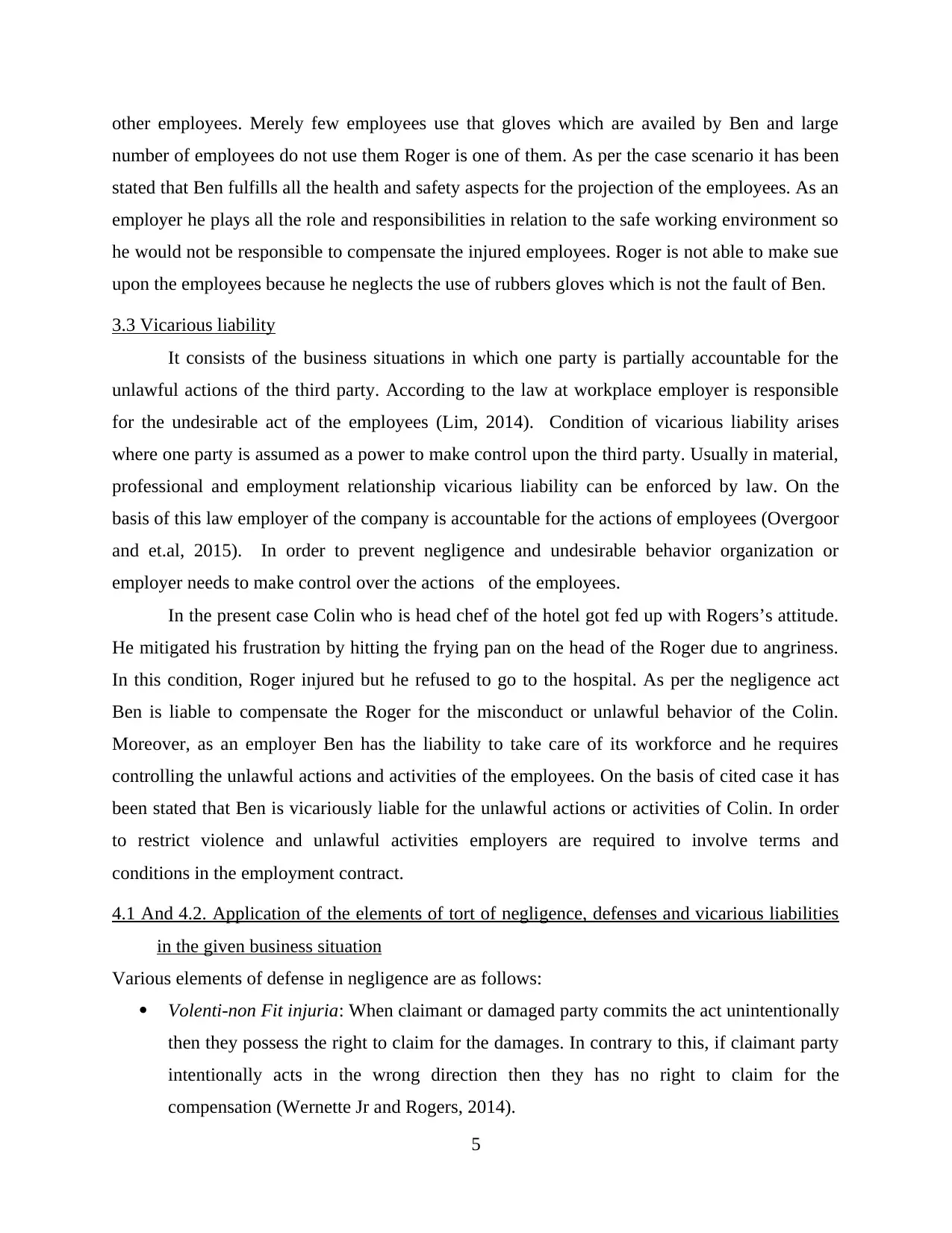
other employees. Merely few employees use that gloves which are availed by Ben and large
number of employees do not use them Roger is one of them. As per the case scenario it has been
stated that Ben fulfills all the health and safety aspects for the projection of the employees. As an
employer he plays all the role and responsibilities in relation to the safe working environment so
he would not be responsible to compensate the injured employees. Roger is not able to make sue
upon the employees because he neglects the use of rubbers gloves which is not the fault of Ben.
3.3 Vicarious liability
It consists of the business situations in which one party is partially accountable for the
unlawful actions of the third party. According to the law at workplace employer is responsible
for the undesirable act of the employees (Lim, 2014). Condition of vicarious liability arises
where one party is assumed as a power to make control upon the third party. Usually in material,
professional and employment relationship vicarious liability can be enforced by law. On the
basis of this law employer of the company is accountable for the actions of employees (Overgoor
and et.al, 2015). In order to prevent negligence and undesirable behavior organization or
employer needs to make control over the actions of the employees.
In the present case Colin who is head chef of the hotel got fed up with Rogers’s attitude.
He mitigated his frustration by hitting the frying pan on the head of the Roger due to angriness.
In this condition, Roger injured but he refused to go to the hospital. As per the negligence act
Ben is liable to compensate the Roger for the misconduct or unlawful behavior of the Colin.
Moreover, as an employer Ben has the liability to take care of its workforce and he requires
controlling the unlawful actions and activities of the employees. On the basis of cited case it has
been stated that Ben is vicariously liable for the unlawful actions or activities of Colin. In order
to restrict violence and unlawful activities employers are required to involve terms and
conditions in the employment contract.
4.1 And 4.2. Application of the elements of tort of negligence, defenses and vicarious liabilities
in the given business situation
Various elements of defense in negligence are as follows:
Volenti-non Fit injuria: When claimant or damaged party commits the act unintentionally
then they possess the right to claim for the damages. In contrary to this, if claimant party
intentionally acts in the wrong direction then they has no right to claim for the
compensation (Wernette Jr and Rogers, 2014).
5
number of employees do not use them Roger is one of them. As per the case scenario it has been
stated that Ben fulfills all the health and safety aspects for the projection of the employees. As an
employer he plays all the role and responsibilities in relation to the safe working environment so
he would not be responsible to compensate the injured employees. Roger is not able to make sue
upon the employees because he neglects the use of rubbers gloves which is not the fault of Ben.
3.3 Vicarious liability
It consists of the business situations in which one party is partially accountable for the
unlawful actions of the third party. According to the law at workplace employer is responsible
for the undesirable act of the employees (Lim, 2014). Condition of vicarious liability arises
where one party is assumed as a power to make control upon the third party. Usually in material,
professional and employment relationship vicarious liability can be enforced by law. On the
basis of this law employer of the company is accountable for the actions of employees (Overgoor
and et.al, 2015). In order to prevent negligence and undesirable behavior organization or
employer needs to make control over the actions of the employees.
In the present case Colin who is head chef of the hotel got fed up with Rogers’s attitude.
He mitigated his frustration by hitting the frying pan on the head of the Roger due to angriness.
In this condition, Roger injured but he refused to go to the hospital. As per the negligence act
Ben is liable to compensate the Roger for the misconduct or unlawful behavior of the Colin.
Moreover, as an employer Ben has the liability to take care of its workforce and he requires
controlling the unlawful actions and activities of the employees. On the basis of cited case it has
been stated that Ben is vicariously liable for the unlawful actions or activities of Colin. In order
to restrict violence and unlawful activities employers are required to involve terms and
conditions in the employment contract.
4.1 And 4.2. Application of the elements of tort of negligence, defenses and vicarious liabilities
in the given business situation
Various elements of defense in negligence are as follows:
Volenti-non Fit injuria: When claimant or damaged party commits the act unintentionally
then they possess the right to claim for the damages. In contrary to this, if claimant party
intentionally acts in the wrong direction then they has no right to claim for the
compensation (Wernette Jr and Rogers, 2014).
5
Paraphrase This Document
Need a fresh take? Get an instant paraphrase of this document with our AI Paraphraser
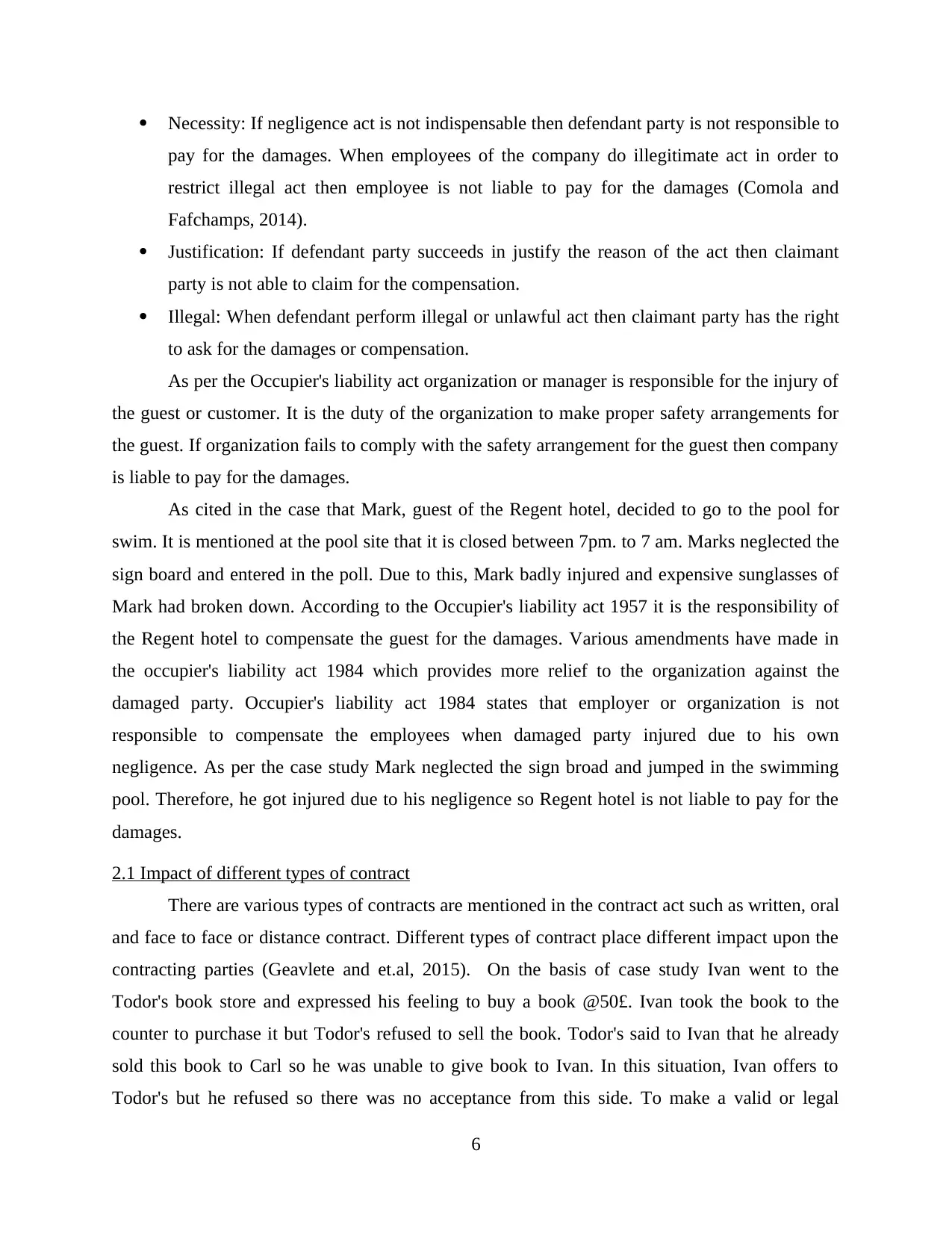
Necessity: If negligence act is not indispensable then defendant party is not responsible to
pay for the damages. When employees of the company do illegitimate act in order to
restrict illegal act then employee is not liable to pay for the damages (Comola and
Fafchamps, 2014).
Justification: If defendant party succeeds in justify the reason of the act then claimant
party is not able to claim for the compensation.
Illegal: When defendant perform illegal or unlawful act then claimant party has the right
to ask for the damages or compensation.
As per the Occupier's liability act organization or manager is responsible for the injury of
the guest or customer. It is the duty of the organization to make proper safety arrangements for
the guest. If organization fails to comply with the safety arrangement for the guest then company
is liable to pay for the damages.
As cited in the case that Mark, guest of the Regent hotel, decided to go to the pool for
swim. It is mentioned at the pool site that it is closed between 7pm. to 7 am. Marks neglected the
sign board and entered in the poll. Due to this, Mark badly injured and expensive sunglasses of
Mark had broken down. According to the Occupier's liability act 1957 it is the responsibility of
the Regent hotel to compensate the guest for the damages. Various amendments have made in
the occupier's liability act 1984 which provides more relief to the organization against the
damaged party. Occupier's liability act 1984 states that employer or organization is not
responsible to compensate the employees when damaged party injured due to his own
negligence. As per the case study Mark neglected the sign broad and jumped in the swimming
pool. Therefore, he got injured due to his negligence so Regent hotel is not liable to pay for the
damages.
2.1 Impact of different types of contract
There are various types of contracts are mentioned in the contract act such as written, oral
and face to face or distance contract. Different types of contract place different impact upon the
contracting parties (Geavlete and et.al, 2015). On the basis of case study Ivan went to the
Todor's book store and expressed his feeling to buy a book @50£. Ivan took the book to the
counter to purchase it but Todor's refused to sell the book. Todor's said to Ivan that he already
sold this book to Carl so he was unable to give book to Ivan. In this situation, Ivan offers to
Todor's but he refused so there was no acceptance from this side. To make a valid or legal
6
pay for the damages. When employees of the company do illegitimate act in order to
restrict illegal act then employee is not liable to pay for the damages (Comola and
Fafchamps, 2014).
Justification: If defendant party succeeds in justify the reason of the act then claimant
party is not able to claim for the compensation.
Illegal: When defendant perform illegal or unlawful act then claimant party has the right
to ask for the damages or compensation.
As per the Occupier's liability act organization or manager is responsible for the injury of
the guest or customer. It is the duty of the organization to make proper safety arrangements for
the guest. If organization fails to comply with the safety arrangement for the guest then company
is liable to pay for the damages.
As cited in the case that Mark, guest of the Regent hotel, decided to go to the pool for
swim. It is mentioned at the pool site that it is closed between 7pm. to 7 am. Marks neglected the
sign board and entered in the poll. Due to this, Mark badly injured and expensive sunglasses of
Mark had broken down. According to the Occupier's liability act 1957 it is the responsibility of
the Regent hotel to compensate the guest for the damages. Various amendments have made in
the occupier's liability act 1984 which provides more relief to the organization against the
damaged party. Occupier's liability act 1984 states that employer or organization is not
responsible to compensate the employees when damaged party injured due to his own
negligence. As per the case study Mark neglected the sign broad and jumped in the swimming
pool. Therefore, he got injured due to his negligence so Regent hotel is not liable to pay for the
damages.
2.1 Impact of different types of contract
There are various types of contracts are mentioned in the contract act such as written, oral
and face to face or distance contract. Different types of contract place different impact upon the
contracting parties (Geavlete and et.al, 2015). On the basis of case study Ivan went to the
Todor's book store and expressed his feeling to buy a book @50£. Ivan took the book to the
counter to purchase it but Todor's refused to sell the book. Todor's said to Ivan that he already
sold this book to Carl so he was unable to give book to Ivan. In this situation, Ivan offers to
Todor's but he refused so there was no acceptance from this side. To make a valid or legal
6
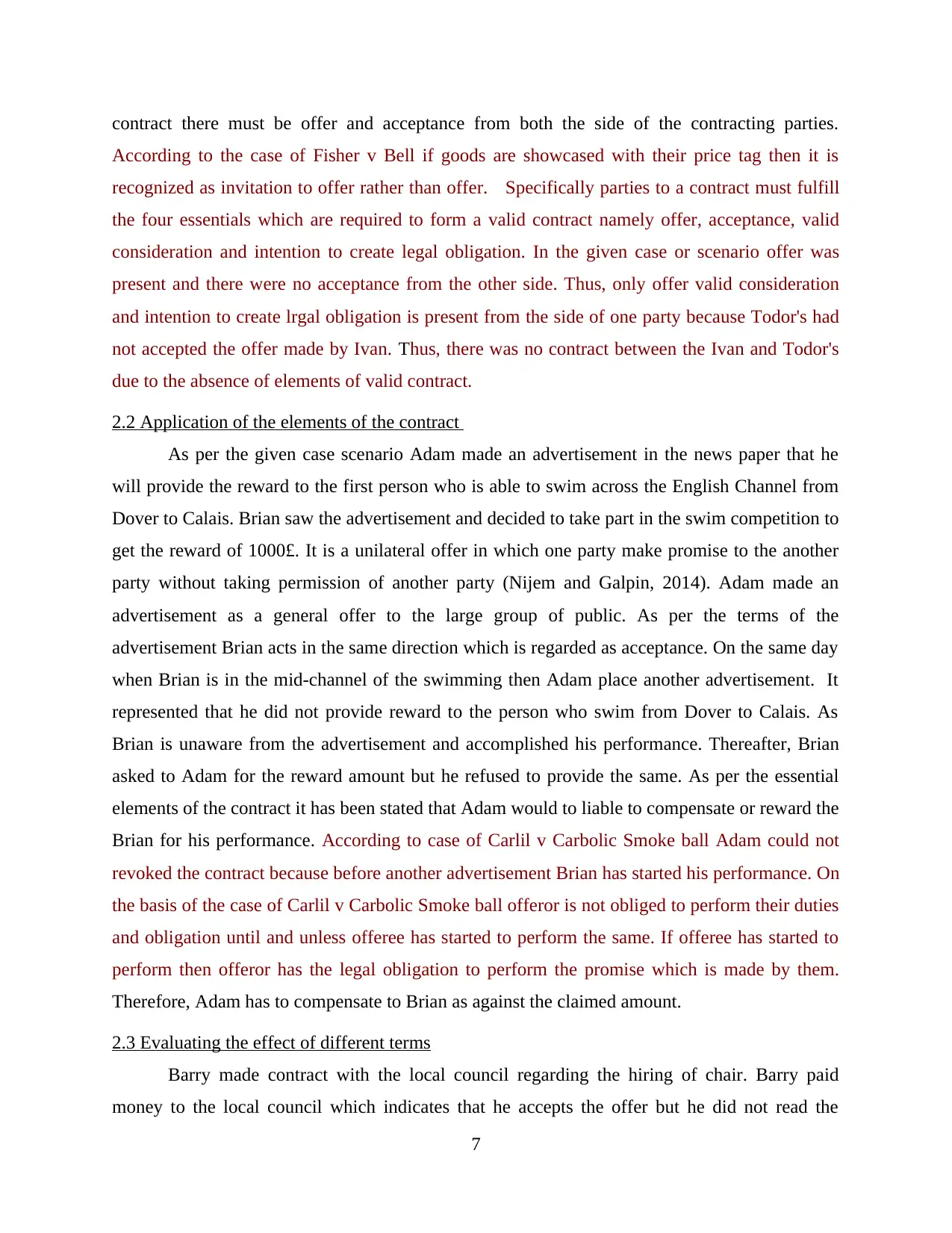
contract there must be offer and acceptance from both the side of the contracting parties.
According to the case of Fisher v Bell if goods are showcased with their price tag then it is
recognized as invitation to offer rather than offer. Specifically parties to a contract must fulfill
the four essentials which are required to form a valid contract namely offer, acceptance, valid
consideration and intention to create legal obligation. In the given case or scenario offer was
present and there were no acceptance from the other side. Thus, only offer valid consideration
and intention to create lrgal obligation is present from the side of one party because Todor's had
not accepted the offer made by Ivan. Thus, there was no contract between the Ivan and Todor's
due to the absence of elements of valid contract.
2.2 Application of the elements of the contract
As per the given case scenario Adam made an advertisement in the news paper that he
will provide the reward to the first person who is able to swim across the English Channel from
Dover to Calais. Brian saw the advertisement and decided to take part in the swim competition to
get the reward of 1000£. It is a unilateral offer in which one party make promise to the another
party without taking permission of another party (Nijem and Galpin, 2014). Adam made an
advertisement as a general offer to the large group of public. As per the terms of the
advertisement Brian acts in the same direction which is regarded as acceptance. On the same day
when Brian is in the mid-channel of the swimming then Adam place another advertisement. It
represented that he did not provide reward to the person who swim from Dover to Calais. As
Brian is unaware from the advertisement and accomplished his performance. Thereafter, Brian
asked to Adam for the reward amount but he refused to provide the same. As per the essential
elements of the contract it has been stated that Adam would to liable to compensate or reward the
Brian for his performance. According to case of Carlil v Carbolic Smoke ball Adam could not
revoked the contract because before another advertisement Brian has started his performance. On
the basis of the case of Carlil v Carbolic Smoke ball offeror is not obliged to perform their duties
and obligation until and unless offeree has started to perform the same. If offeree has started to
perform then offeror has the legal obligation to perform the promise which is made by them.
Therefore, Adam has to compensate to Brian as against the claimed amount.
2.3 Evaluating the effect of different terms
Barry made contract with the local council regarding the hiring of chair. Barry paid
money to the local council which indicates that he accepts the offer but he did not read the
7
According to the case of Fisher v Bell if goods are showcased with their price tag then it is
recognized as invitation to offer rather than offer. Specifically parties to a contract must fulfill
the four essentials which are required to form a valid contract namely offer, acceptance, valid
consideration and intention to create legal obligation. In the given case or scenario offer was
present and there were no acceptance from the other side. Thus, only offer valid consideration
and intention to create lrgal obligation is present from the side of one party because Todor's had
not accepted the offer made by Ivan. Thus, there was no contract between the Ivan and Todor's
due to the absence of elements of valid contract.
2.2 Application of the elements of the contract
As per the given case scenario Adam made an advertisement in the news paper that he
will provide the reward to the first person who is able to swim across the English Channel from
Dover to Calais. Brian saw the advertisement and decided to take part in the swim competition to
get the reward of 1000£. It is a unilateral offer in which one party make promise to the another
party without taking permission of another party (Nijem and Galpin, 2014). Adam made an
advertisement as a general offer to the large group of public. As per the terms of the
advertisement Brian acts in the same direction which is regarded as acceptance. On the same day
when Brian is in the mid-channel of the swimming then Adam place another advertisement. It
represented that he did not provide reward to the person who swim from Dover to Calais. As
Brian is unaware from the advertisement and accomplished his performance. Thereafter, Brian
asked to Adam for the reward amount but he refused to provide the same. As per the essential
elements of the contract it has been stated that Adam would to liable to compensate or reward the
Brian for his performance. According to case of Carlil v Carbolic Smoke ball Adam could not
revoked the contract because before another advertisement Brian has started his performance. On
the basis of the case of Carlil v Carbolic Smoke ball offeror is not obliged to perform their duties
and obligation until and unless offeree has started to perform the same. If offeree has started to
perform then offeror has the legal obligation to perform the promise which is made by them.
Therefore, Adam has to compensate to Brian as against the claimed amount.
2.3 Evaluating the effect of different terms
Barry made contract with the local council regarding the hiring of chair. Barry paid
money to the local council which indicates that he accepts the offer but he did not read the
7
⊘ This is a preview!⊘
Do you want full access?
Subscribe today to unlock all pages.

Trusted by 1+ million students worldwide
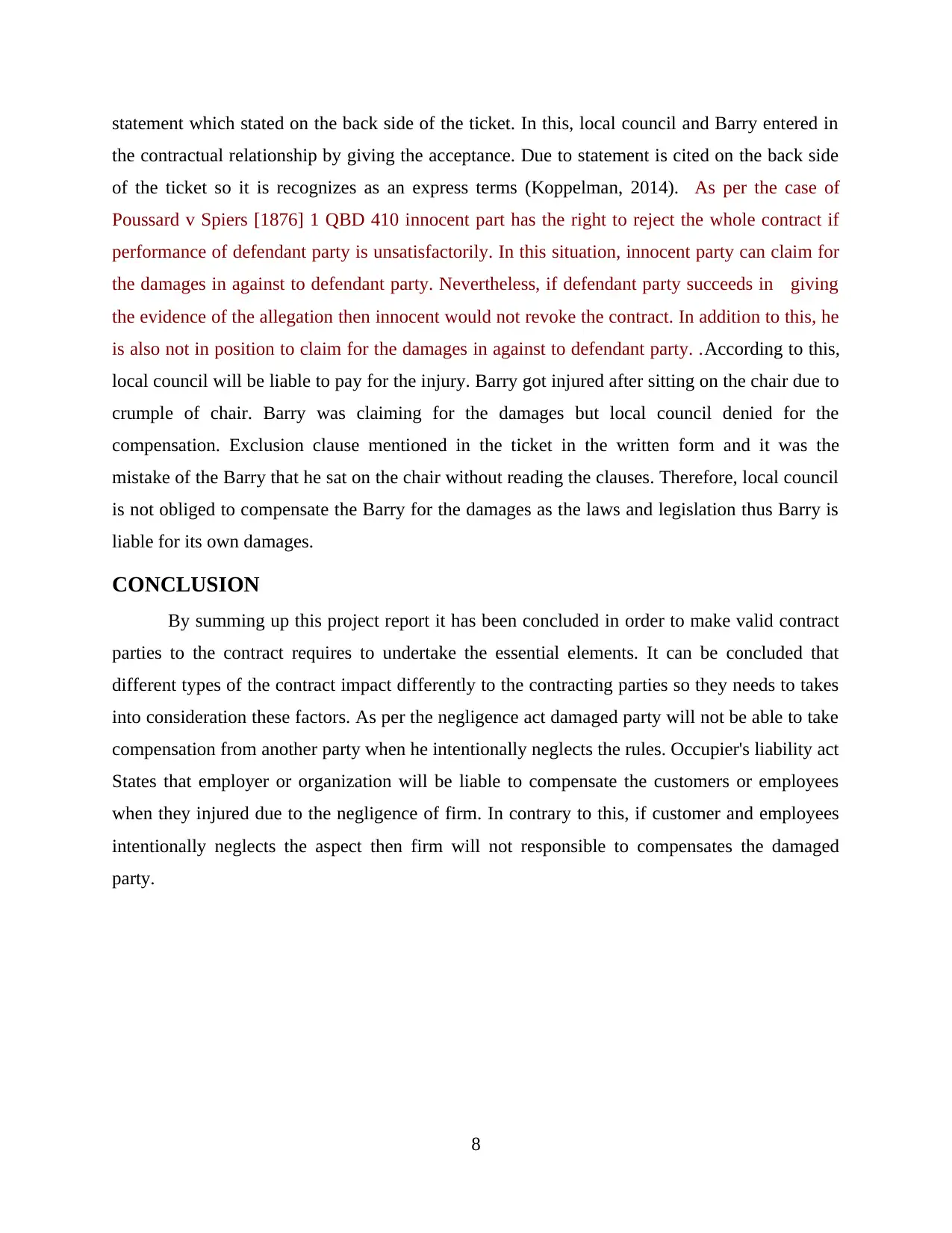
statement which stated on the back side of the ticket. In this, local council and Barry entered in
the contractual relationship by giving the acceptance. Due to statement is cited on the back side
of the ticket so it is recognizes as an express terms (Koppelman, 2014). As per the case of
Poussard v Spiers [1876] 1 QBD 410 innocent part has the right to reject the whole contract if
performance of defendant party is unsatisfactorily. In this situation, innocent party can claim for
the damages in against to defendant party. Nevertheless, if defendant party succeeds in giving
the evidence of the allegation then innocent would not revoke the contract. In addition to this, he
is also not in position to claim for the damages in against to defendant party. .According to this,
local council will be liable to pay for the injury. Barry got injured after sitting on the chair due to
crumple of chair. Barry was claiming for the damages but local council denied for the
compensation. Exclusion clause mentioned in the ticket in the written form and it was the
mistake of the Barry that he sat on the chair without reading the clauses. Therefore, local council
is not obliged to compensate the Barry for the damages as the laws and legislation thus Barry is
liable for its own damages.
CONCLUSION
By summing up this project report it has been concluded in order to make valid contract
parties to the contract requires to undertake the essential elements. It can be concluded that
different types of the contract impact differently to the contracting parties so they needs to takes
into consideration these factors. As per the negligence act damaged party will not be able to take
compensation from another party when he intentionally neglects the rules. Occupier's liability act
States that employer or organization will be liable to compensate the customers or employees
when they injured due to the negligence of firm. In contrary to this, if customer and employees
intentionally neglects the aspect then firm will not responsible to compensates the damaged
party.
8
the contractual relationship by giving the acceptance. Due to statement is cited on the back side
of the ticket so it is recognizes as an express terms (Koppelman, 2014). As per the case of
Poussard v Spiers [1876] 1 QBD 410 innocent part has the right to reject the whole contract if
performance of defendant party is unsatisfactorily. In this situation, innocent party can claim for
the damages in against to defendant party. Nevertheless, if defendant party succeeds in giving
the evidence of the allegation then innocent would not revoke the contract. In addition to this, he
is also not in position to claim for the damages in against to defendant party. .According to this,
local council will be liable to pay for the injury. Barry got injured after sitting on the chair due to
crumple of chair. Barry was claiming for the damages but local council denied for the
compensation. Exclusion clause mentioned in the ticket in the written form and it was the
mistake of the Barry that he sat on the chair without reading the clauses. Therefore, local council
is not obliged to compensate the Barry for the damages as the laws and legislation thus Barry is
liable for its own damages.
CONCLUSION
By summing up this project report it has been concluded in order to make valid contract
parties to the contract requires to undertake the essential elements. It can be concluded that
different types of the contract impact differently to the contracting parties so they needs to takes
into consideration these factors. As per the negligence act damaged party will not be able to take
compensation from another party when he intentionally neglects the rules. Occupier's liability act
States that employer or organization will be liable to compensate the customers or employees
when they injured due to the negligence of firm. In contrary to this, if customer and employees
intentionally neglects the aspect then firm will not responsible to compensates the damaged
party.
8
Paraphrase This Document
Need a fresh take? Get an instant paraphrase of this document with our AI Paraphraser
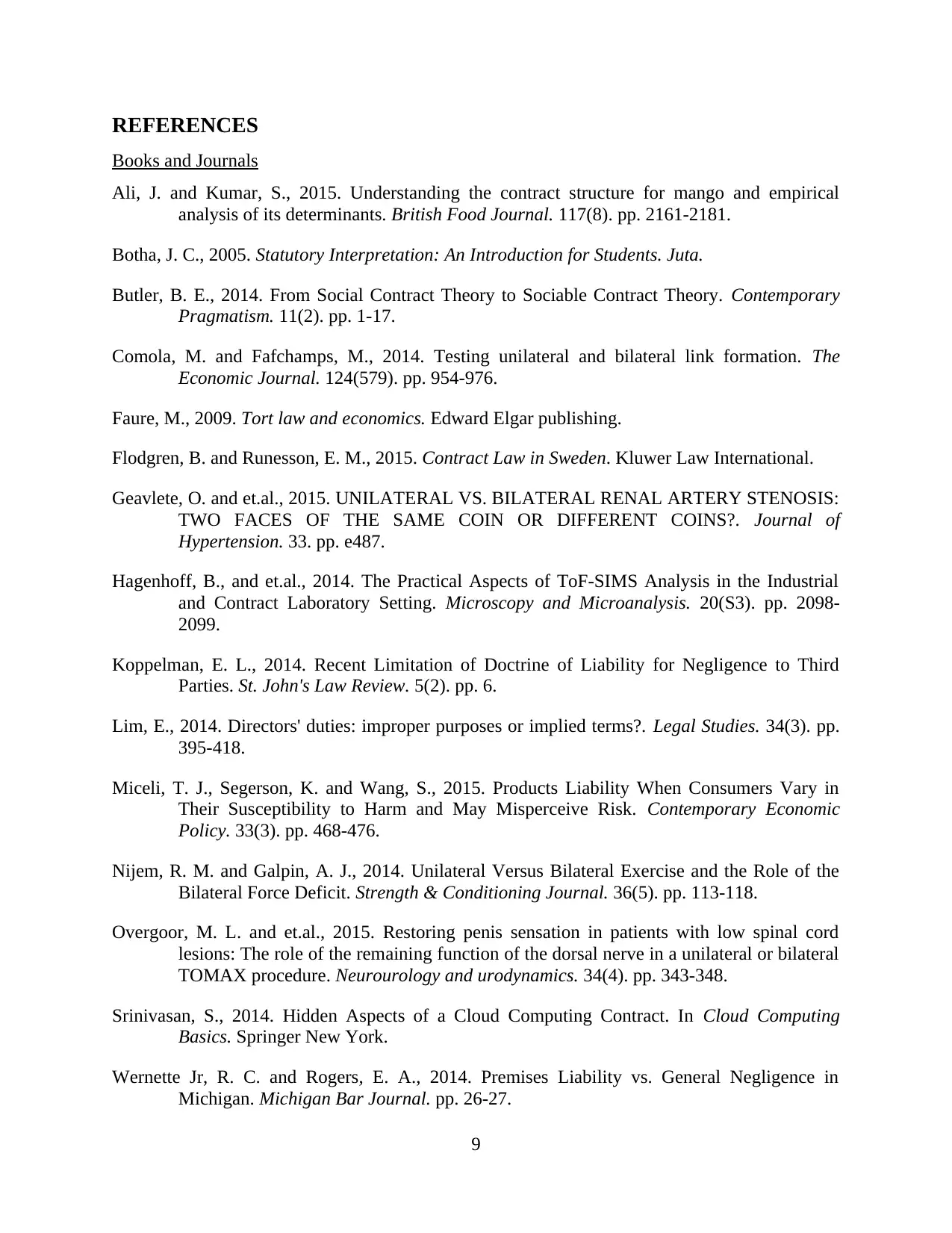
REFERENCES
Books and Journals
Ali, J. and Kumar, S., 2015. Understanding the contract structure for mango and empirical
analysis of its determinants. British Food Journal. 117(8). pp. 2161-2181.
Botha, J. C., 2005. Statutory Interpretation: An Introduction for Students. Juta.
Butler, B. E., 2014. From Social Contract Theory to Sociable Contract Theory. Contemporary
Pragmatism. 11(2). pp. 1-17.
Comola, M. and Fafchamps, M., 2014. Testing unilateral and bilateral link formation. The
Economic Journal. 124(579). pp. 954-976.
Faure, M., 2009. Tort law and economics. Edward Elgar publishing.
Flodgren, B. and Runesson, E. M., 2015. Contract Law in Sweden. Kluwer Law International.
Geavlete, O. and et.al., 2015. UNILATERAL VS. BILATERAL RENAL ARTERY STENOSIS:
TWO FACES OF THE SAME COIN OR DIFFERENT COINS?. Journal of
Hypertension. 33. pp. e487.
Hagenhoff, B., and et.al., 2014. The Practical Aspects of ToF-SIMS Analysis in the Industrial
and Contract Laboratory Setting. Microscopy and Microanalysis. 20(S3). pp. 2098-
2099.
Koppelman, E. L., 2014. Recent Limitation of Doctrine of Liability for Negligence to Third
Parties. St. John's Law Review. 5(2). pp. 6.
Lim, E., 2014. Directors' duties: improper purposes or implied terms?. Legal Studies. 34(3). pp.
395-418.
Miceli, T. J., Segerson, K. and Wang, S., 2015. Products Liability When Consumers Vary in
Their Susceptibility to Harm and May Misperceive Risk. Contemporary Economic
Policy. 33(3). pp. 468-476.
Nijem, R. M. and Galpin, A. J., 2014. Unilateral Versus Bilateral Exercise and the Role of the
Bilateral Force Deficit. Strength & Conditioning Journal. 36(5). pp. 113-118.
Overgoor, M. L. and et.al., 2015. Restoring penis sensation in patients with low spinal cord
lesions: The role of the remaining function of the dorsal nerve in a unilateral or bilateral
TOMAX procedure. Neurourology and urodynamics. 34(4). pp. 343-348.
Srinivasan, S., 2014. Hidden Aspects of a Cloud Computing Contract. In Cloud Computing
Basics. Springer New York.
Wernette Jr, R. C. and Rogers, E. A., 2014. Premises Liability vs. General Negligence in
Michigan. Michigan Bar Journal. pp. 26-27.
9
Books and Journals
Ali, J. and Kumar, S., 2015. Understanding the contract structure for mango and empirical
analysis of its determinants. British Food Journal. 117(8). pp. 2161-2181.
Botha, J. C., 2005. Statutory Interpretation: An Introduction for Students. Juta.
Butler, B. E., 2014. From Social Contract Theory to Sociable Contract Theory. Contemporary
Pragmatism. 11(2). pp. 1-17.
Comola, M. and Fafchamps, M., 2014. Testing unilateral and bilateral link formation. The
Economic Journal. 124(579). pp. 954-976.
Faure, M., 2009. Tort law and economics. Edward Elgar publishing.
Flodgren, B. and Runesson, E. M., 2015. Contract Law in Sweden. Kluwer Law International.
Geavlete, O. and et.al., 2015. UNILATERAL VS. BILATERAL RENAL ARTERY STENOSIS:
TWO FACES OF THE SAME COIN OR DIFFERENT COINS?. Journal of
Hypertension. 33. pp. e487.
Hagenhoff, B., and et.al., 2014. The Practical Aspects of ToF-SIMS Analysis in the Industrial
and Contract Laboratory Setting. Microscopy and Microanalysis. 20(S3). pp. 2098-
2099.
Koppelman, E. L., 2014. Recent Limitation of Doctrine of Liability for Negligence to Third
Parties. St. John's Law Review. 5(2). pp. 6.
Lim, E., 2014. Directors' duties: improper purposes or implied terms?. Legal Studies. 34(3). pp.
395-418.
Miceli, T. J., Segerson, K. and Wang, S., 2015. Products Liability When Consumers Vary in
Their Susceptibility to Harm and May Misperceive Risk. Contemporary Economic
Policy. 33(3). pp. 468-476.
Nijem, R. M. and Galpin, A. J., 2014. Unilateral Versus Bilateral Exercise and the Role of the
Bilateral Force Deficit. Strength & Conditioning Journal. 36(5). pp. 113-118.
Overgoor, M. L. and et.al., 2015. Restoring penis sensation in patients with low spinal cord
lesions: The role of the remaining function of the dorsal nerve in a unilateral or bilateral
TOMAX procedure. Neurourology and urodynamics. 34(4). pp. 343-348.
Srinivasan, S., 2014. Hidden Aspects of a Cloud Computing Contract. In Cloud Computing
Basics. Springer New York.
Wernette Jr, R. C. and Rogers, E. A., 2014. Premises Liability vs. General Negligence in
Michigan. Michigan Bar Journal. pp. 26-27.
9
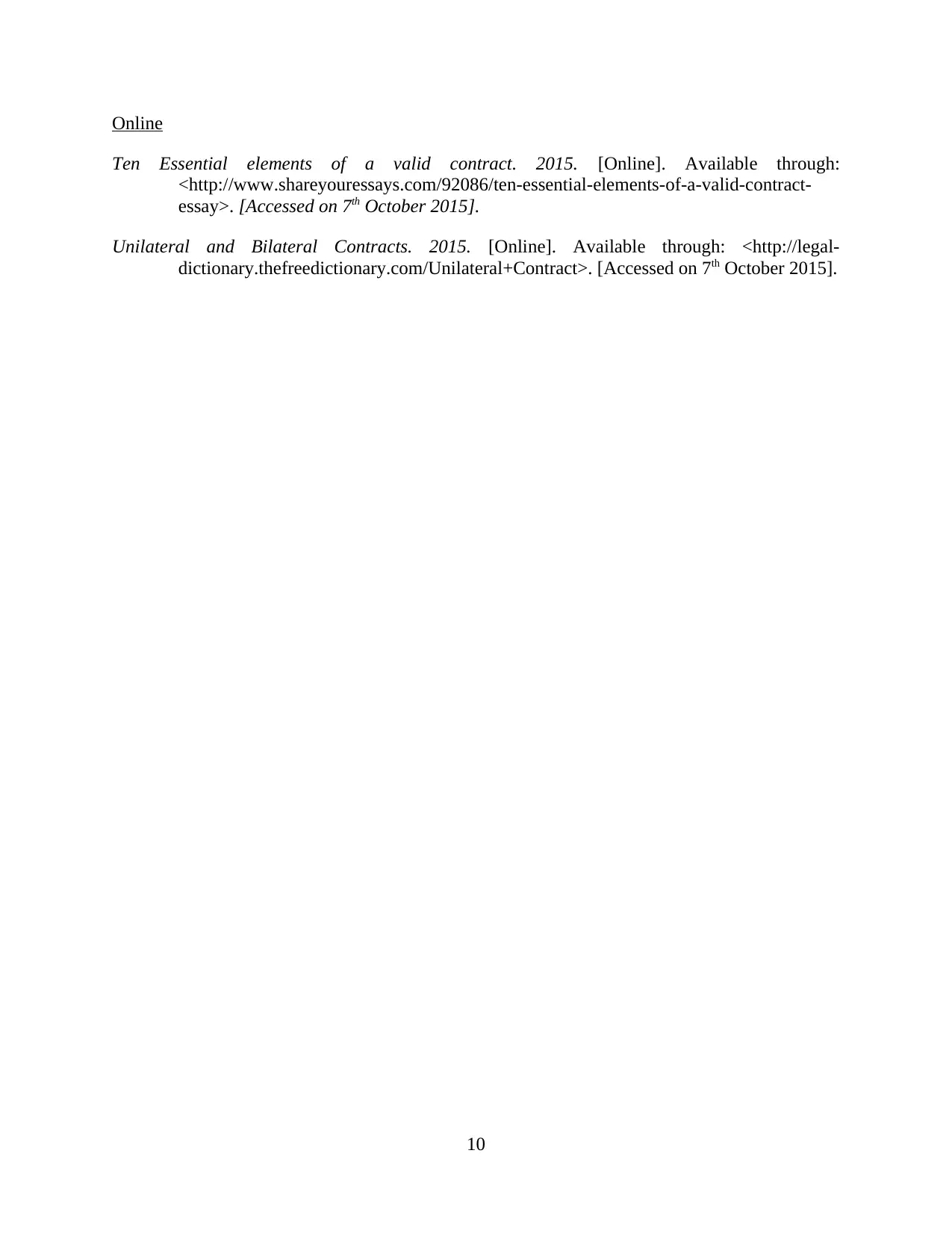
Online
Ten Essential elements of a valid contract. 2015. [Online]. Available through:
<http://www.shareyouressays.com/92086/ten-essential-elements-of-a-valid-contract-
essay>. [Accessed on 7th October 2015].
Unilateral and Bilateral Contracts. 2015. [Online]. Available through: <http://legal-
dictionary.thefreedictionary.com/Unilateral+Contract>. [Accessed on 7th October 2015].
10
Ten Essential elements of a valid contract. 2015. [Online]. Available through:
<http://www.shareyouressays.com/92086/ten-essential-elements-of-a-valid-contract-
essay>. [Accessed on 7th October 2015].
Unilateral and Bilateral Contracts. 2015. [Online]. Available through: <http://legal-
dictionary.thefreedictionary.com/Unilateral+Contract>. [Accessed on 7th October 2015].
10
⊘ This is a preview!⊘
Do you want full access?
Subscribe today to unlock all pages.

Trusted by 1+ million students worldwide
1 out of 12
Related Documents
Your All-in-One AI-Powered Toolkit for Academic Success.
+13062052269
info@desklib.com
Available 24*7 on WhatsApp / Email
![[object Object]](/_next/static/media/star-bottom.7253800d.svg)
Unlock your academic potential
Copyright © 2020–2025 A2Z Services. All Rights Reserved. Developed and managed by ZUCOL.




